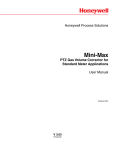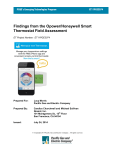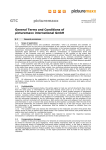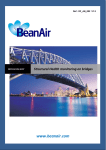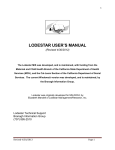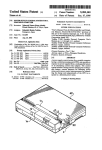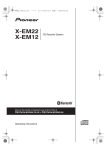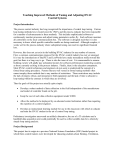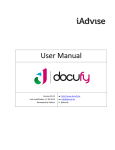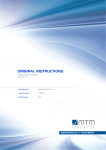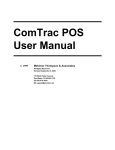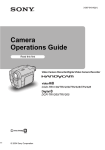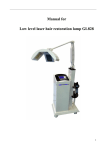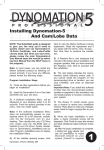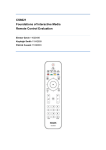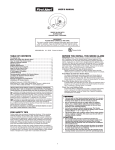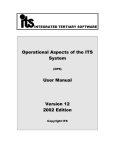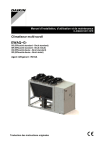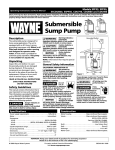Download PG&E`s Emerging Technologies Program
Transcript
PG&E’s Emerging Technologies Program ET11PGE3073 Opower/Honeywell Thermostat Trial – Interim Findings ET Project Number: ET11PGE3073 Product Manager: Olya Zaretsky Pacific Gas and Electric Company Prepared By: Michael Perry and Jeeheh Oh Freeman, Sullivan & Co. 101 Montgomery St., 15th floor San Francisco, CA 94104 Issued: December 12, 2012 Copyright, 2012, Pacific Gas and Electric Company. All rights reserved. PG&E’s Emerging Technologies Program ET11PGE3073 ACKNOWLEDGEMENTS Pacific Gas and Electric Company’s Emerging Technologies Program is responsible for this project. It was developed under internal project number ET11PGE3073. Michael Perry of Freeman, Sullivan & Co. conducted this technology evaluation for Pacific Gas and Electric Company with assistance from Jeeheh Oh and overall guidance and management from Olya Zaretsky. For more information on this project, contact [email protected]. LEGAL NOTICE This report was prepared for Pacific Gas and Electric Company for use by its employees and agents. Neither Pacific Gas and Electric Company nor any of its employees and agents: (1) makes any written or oral warranty, expressed or implied, including, but not limited to those concerning merchantability or fitness for a particular purpose; (2) assumes any legal liability or responsibility for the accuracy, completeness, or usefulness of any information, apparatus, product, process, method, or policy contained herein; or (3) represents that its use would not infringe any privately owned rights, including, but not limited to, patents, trademarks, or copyrights. PG&E’s Emerging Technologies Program ABBREVIATIONS AND ACRONYMS HVAC Heating, Ventilation and Air Conditioning PC Personal Computer App Software application—either on an iPhone or a PC RCT Randomized controlled trial ET11PGE3073 PG&E’s Emerging Technologies Program TABLES Table 1: Average Responses to Installation Survey ......................... 14 Table 2: Frequency of Responses to Motivation for Participation Questions and Average Response .................................17 Table 3: Frequency of Responses to Overall Impression Questions and Average Response ................................................18 Table 4: Frequency of Responses to Helpfulness Questions and Average Response ...................................................... 18 Table 5: Tallies of Responses to Degree of Agreement Questions .....21 Table 6: Frequency of Responses to Frequency of Use and Effect Questions ..................................................................22 Table 7: Rankings of Possible Energy Reduction Factors ..................23 Table 8: If Yes, How would you like to receive additional information? (Choose all that Apply) ............................. 24 Table 9: Customer Characteristics ................................................26 Table 10: Treatment Control Comparison ......................................28 FIGURES Figure 1: Treatment, Control and Installed Customers ....................14 Figure 2: Locations of Recruiting and test groups ........................... 25 Figure 3: Customer Monthly Usage ...............................................27 ET11PGE3073 PG&E’s Emerging Technologies Program CONTENTS EXECUTIVE SUMMARY 5 INTRODUCTION 8 BACKGROUND 8 EMERGING TECHNOLOGY/PRODUCT 10 ASSESSMENT OBJECTIVES 10 TECHNOLOGY/PRODUCT EVALUATION 11 TECHNICAL APPROACH/TEST METHODOLOGY 12 Field Testing of Technology 12 Test Plan 12 RESULTS 13 Customer Recruitment and thermostat installation 13 Survey of Participants 15 Motivation for Participation and Method of Enrollment 16 Motivation for Participation 16 Method of Enrollment 17 Overall Impression and Helpfulness Responses and Comments 17 Enrollment Process 19 iPhone App 19 Website Portal 19 Receiving Messages from Website and iPhone App: Positive or Negative Experience? 20 Messages from Website and iPhone: Helpful or Unhelpful? 20 Customer Service 20 Degree of Agreement Questions 20 Frequency of Use and Effect 22 Issues 23 Additional Support Materials 23 Participant Characteristics 24 EVALUATIONS 29 RECOMMENDATIONS 29 APPENDIX A SURVEY INSTRUMENT 30 ET11PGE3073 PG&E’s Emerging Technologies Program EXECUTIVE SUMMARY This emerging technology report documents the results from the initial installations of the Honeywell communicating thermostat and Opower behavioral software trial. The thermostat includes programming that allows it to be remotely programmed through an iPhone app or a PC-based app. It also has the functionality to push messages to participants through the iPhone app, alerting them to important aspects of their energy use. In this trial, 888 customers have been recruited into the trial program through a series of marketing events conducted outside selected retail stores, malls, festivals and farmers' markets in Contra Costa, Yolo, San Joaquin and Solano counties. Of those 888 customers, 824 customers completed online enrollment and were randomly assigned to treatment and control groups. 421 were randomly assigned to be in the treatment group and made appointments for Honeywell technicians to install the trial thermostat at their home. Of those, 276 had successful thermostat installations. The remaining 403 were randomly assigned to be in a control group for evaluation, measurement and verification (EM&V) purposes. This control group has not and will not receive the thermostat. They are included in the project in order to provide a benchmark set of usage data for customers with characteristics comparable to those who were assigned to receive a thermostat. They have comparable characteristics because they were chosen randomly from the group of customers who were eligible for and interested in receiving the thermostat. Throughout this report, the term treatment group refers to all customers who were randomly assigned to receive a thermostat, whether installation was successful or not. The term installed group refers to the group within the treatment group for which installation was successful. The term control group refers to the customers who were determined to be eligible for the trial and wanted the thermostat, but who were randomly assigned not to receive a thermostat. Honeywell technicians installed the devices and made sure that participants’ iPhones were set up with the app. Participants received instructions on how to use the device and the apps. Recruiting has not yet finished, so this report only documents results for a portion of what will ultimately be the full test population. With that in mind, the treatment and control populations that have been recruited and assigned thus far show no signs of selection bias, which is an indicator that the energy savings estimates that ultimately come from this trial will be accurate. Customers with successful installations were surveyed over the internet. The survey took place in mid-November, after customers had the thermostat installed for 2-3 months. The survey achieved a 52% response rate, with 145 customers responding out of a pool of 276. Survey results indicate a positive response to the thermostat and installation process so far. Customers particularly enjoy being able to remotely control their thermostat and most would recommend the thermostat to a friend. 5 PG&E’s Emerging Technologies Program PROJECT GOAL The goal of the trial is to test the customer experience and energy savings from the thermostat and behavioral software solution. The thermostat and associated software are intended to bring about several behavioral changes in customers with respect to how they heat and cool their homes, including: • Driving a higher percentage of customers to program their thermostats with a custom schedule; • Motivating customers to set a more efficient temperature when home; • Increasing set-back temperatures (i.e., automating systems when customers are away from home); and • Expanding the length of the set-back period. PROJECT DESCRIPTION The evaluation of the trial up to this point consists of three main pieces. The first piece consists of an evaluation of the recruitment and installation process. The second piece is an analysis of the characteristics of customers recruited into the trial. The third piece is a summary of results of a survey done on customers with installed devices. A future report on this trial will contain energy savings estimates. The results of the trial thus far are not focused on energy savings or cost savings. They are focused on understanding the recruitment and installation process and customer experience thus far. PROJECT FINDINGS/RESULTS The main findings regarding the recruitment and installation process include: • Customers with a successfully installed thermostat have a good impression of the recruitment and installation process; • There are anecdotal reports of customer dissatisfaction at being assigned to the control group; and • The number of treatment group customers without a thermostat installed is a problem that could compromise the precision of energy savings estimates when the impact evaluation is conducted once the trial is fully enrolled. 6 PG&E’s Emerging Technologies Program The key findings from the customer survey were: • Most respondents were attracted to the trial by the functionality of the thermostat, which allowed them to remotely control it; • Respondents generally gave high scores to the enrollment process, to the thermostat itself and to the iPhone app; • Customers mentioned some minor technical problems such as the enrollment website going down and the iPhone app having trouble connecting to the thermostat; and • Customers responded with a high level of agreement to the phrases, “I’m glad I signed up for the program” and “I would recommend the thermostat and app to a friend.” Finally, the main findings regarding customer characteristics include: • Customers in the trial have substantially higher energy usage and tend to have higher incomes than the broader PG&E population; • Customers with successful thermostat installations have similar characteristics to the broader treatment and control groups, indicating that installation failure is mainly a random event; and • Treatment group customers are comparable to control group customers across all observable variables, indicating a well-implemented experiment thus far. PROJECT RECOMMENDATIONS Recommendations from the trial so far are to continue to recruit until the test group reaches a size appropriate for estimating energy savings. This will entail a minimum of 500 installed thermostats. Recruitment would be easier if an app was available for smart phones rather than only iPhones and if customers were offered a consolation prize if they were randomly assigned to the control group. Every effort should be made to reduce failed installations at treatment group premises. Note that action is being taken to improve recruitment efforts. An Android version of the smartphone app is available for future customers recruited to participate in the trial. Also, while many of the treatment group customers whose installation could not occur were ineligible to participate, the ineligibility was not determined until an installation was attempted in the customer’s home. In these cases, ineligibility was due to reasons such as incompatible HVAC, the HVAC system not functioning, an ineligible network or phone. In order to further preclude ineligible customers from enrolling in the program, enrollment questions have been revised and clarified. This action should greatly increase the volume of the installed group. 7 PG&E’s Emerging Technologies Program INTRODUCTION This report describes the procedures and results obtained in the first installation phase of the Opower/Honeywell solution trial. The results from this evaluation will support PG&E, Honeywell and Opower in the further execution of this trial. There is much interest in the utility industry in using technology and information treatments to induce behavior change that leads to energy savings. A particular area of interest lately is in using software-enabled thermostats to help customers make more efficient climate control decisions. The thermostat solution tested as part of this trial is an example of this. More information about the thermostat is in the Background section below. It is expected that the thermostat may be able to induce a 5% electricity and somewhat larger gas savings among customers who live in areas where climate control represents a large portion of their energy use. 1 The trial thus far has produced data that allows us to understand the recruitment and installation process, the characteristics of customers recruited and the customer experience after 2-3 months of using the device. This report documents and summarizes that data. The remainder of the report contains background on the trial, followed by a description of the product being tested, and then a discussion of how data has been collected, followed by a discussion of results so far. The report concludes with a summary and recommendations. BACKGROUND Honeywell and Opower, Inc. have collaborated to develop a solution that includes an internet-enabled thermostat and behavioral software that allows residential customers to better manage their climate-control energy use. The thermostat and software make it easier for a customer to allow the temperature in their home to change to more efficient levels when they aren’t home or when they are sleeping. When setting their at-home and during sleep, cooling and heating temperatures, customers are given a prompt if any setting is above or below the recommended setting. They are prompted to set the temperature higher or lower because the home will have cooled or warmed up to a comfortable setting before they wake up. They are also informed of how much money they would save either during winter or summer if they decided upon the recommended temperature setting. Similar prompts appear when setting the temperature for when they are normally away from home. Customers may also use a manual override to make changes to their normal schedule. If a customer chooses a more efficient temperature compared to their present schedule, they are asked if they would like to adopt the new temperature as their present temperature. For example, the message may read: “Would you like to save 79° as your usual temperature for Home? Not saving this temperature could cost you an extra $20 this year.” 1 Opower’s original proposal document for the trial (“Pacific Gas & Electric Honeywell/Opower Thermostat Pilot,” July 2011, prepared by Sean Harrington) contains an analysis estimating total annual electricity savings of 573 kWh for premises in the Sacramento area. This is roughly 5-8% of annual average usage for customers in hotter areas of PG&E’s territory. The same analysis also estimates 40 therms of gas savings per year, which is roughly 8-9% of annual gas usage in the same area. 8 PG&E’s Emerging Technologies Program Additionally, the software provides messages pushed to customers through the smart phone app. Push notifications can be sent five minutes before the heat or cooling system turns on to begin the switch from “Away”/”On Vacation” to “At Home” temperature settings. This notification allows users to set a later time for the system to activate if they’re not going to be home soon. Users can also receive three different push notifications regarding their fan usage: a 2 hour, 8 hour and 24 hour usage warning. The message informs users that their fan has been running continuously for 2, 8 or 24 hours. They are given the option to switch to an “Auto” setting that will run the fan more efficiently. Lastly, customers may be notified that their thermostat is set to “Away” but that someone has adjusted their home thermostat. No other options are given at that point. In early 2012, PG&E conducted an Alpha test of the project, documented in a previous report, 2 in which 17 PG&E employees were recruited and had the thermostat installed at their home. That test went relatively smoothly and the feedback from those employees was used to inform the planning for this wave of the trial. The two main goals for this wave of the trial are to develop an understanding of: • Energy savings potential from reducing residential heating, ventilation and air conditioning (HVAC) consumption through behavioral changes; and • Residential consumer preferences and attitudes towards enabling technologies. HVAC consumption is targeted for this project because it represents approximately 9% of electric consumption and 37% of gas consumption for residential customers in California. 3 However, the percentage of total electric and gas consumption can vary drastically depending on the climate zone. HVAC consumption represents 30% of total electric consumption in several of PG&E’s climate zones, but can range as high as 45% for 2-story homes in specific climate zones. 4 While many customers have programmable thermostats, research shows that the majority of customers do not know how to properly set their thermostats. 5 This suggests that there may be substantial savings available by making it easier for customers to set their thermostats and by providing reminders when it might be advantageous for them to change their settings. The thermostat and software offered in this trial are meant to address this possibility by providing an intuitive programming interface and messaging, each delivered through an app on the customer’s iPhone or PC. See “Findings from the Alpha Test of the Opower/Honeywell Thermostat Pilot” ET Project Number: ET11PGE1072. California Energy Commission. “California Statewide Residential Appliance Saturation Study Final Report Executive Summary.” 2010 4 eQuest – Building Energy Use and Cost Analysis Software, developed by James J. Hirsch & Associates (JJH), version 3.64 was the latest release, http://www.doe2.com/ 5 California Energy Commission. “California Statewide Residential Appliance Saturation Study Final Report Executive Summary.” 2010 2 3 9 PG&E’s Emerging Technologies Program EMERGING TECHNOLOGY/PRODUCT The solution is a combination of a Honeywell internet enabled thermostat with Opower behavioral solution software, which includes normative messaging and recommended schedules through an iPhone application (referred to as an app). The thermostat can also be programmed through a web application on a participant’s PC. Through this messaging, the solution keeps customers better informed about their energy choices and the cost ramifications of those choices. The solution design is intended to make it easy for customers to act and, by using psychological mechanisms and consistent encouragement and feedback, to motivate customers to reduce energy consumption. The product in the home works as a standard programmable thermostat. The innovation is the simplicity of its programming process and its ability to interact with Opower software. The software nudges customers towards using less HVAC energy by making suggestions. The suggestions alert customers to times when the customer could save energy by allowing the home to heat up more in the summer or cool down more in the winter. The thermostat would replace either a conventional non-programmable thermostat or a programmable thermostat. The primary market barrier currently is that the customer must have an iPhone to use with the thermostat, if they want to take full advantage of the mobile control. Opower has since developed the software that will allow the thermostat to work with other types of smart phones (specifically Android, which will be available to remaining customers recruited for the trial). Though a smart phone will always be required for mobile control, a web interface is also available for remote access and control. ASSESSMENT OBJECTIVES The objectives of this trial are to measure energy savings and to understand the customer experience with the thermostat. Energy savings measurements will be accomplished through statistical analysis of monthly usage data after more customers have been recruited and sufficient time has passed for savings to be measured, which capture a heating and cooling season for customers. The primary objectives of the data evaluation in this report are to understand the current test population, to document the recruitment and installation process so far and to determine any improvements that can be made to the process or to the customer experience. Understanding the customer experience and related issues is done through evaluation of the recruitment and installation process and through surveys of customer experience with the thermostat and associated apps. The data from this wave of the project consists of: • The lists of customers who were recruited into the trial, those assigned to the treatment and control groups and those who have had thermostats successfully installed thus far; • Data on the installation success rate of customers recruited into the treatment group and the reasons for installation failure; 10 PG&E’s Emerging Technologies Program • Data on basic demographic characteristics of customers visited by Honeywell installers, which was gathered using a short survey form filled out by customers at installation; • Customer satisfaction results from a survey of customers done at installation; and • Results from an email survey of installed customers performed by Population Research Systems (PRS), the market research arm of Freeman, Sullivan & Co. The customer lists are used to provide comparisons of: the installed and non-installed customers within the treatment group; the treatment and control groups; and the installed and treatment groups to the broader PG&E residential population. Each of these comparisons is useful for understanding the future EM&V effort and also for assessing the potential conservation effect of offering this technology is to the broader PG&E population. The survey data is evaluated through summary tables of survey responses as well as qualitative judgments of comments made to open-ended survey responses. TECHNOLOGY/PRODUCT EVALUATION The evaluation of the thermostat in the current wave of the trial is being done by PG&E customers in a cluster of areas around Yolo, Solana, Contra Costa and San Joaquin counties. The areas were chosen based on the expectation that they would have a high number of eligible and interested customers who could realize measurable energy savings from using the device. The criteria that PG&E customers had to satisfy in order to take part in the trial were that they: • Had to receive electric and gas service from PG&E; • Reside in select zip codes; • Have operational central heating and air-conditioning; • Have an iPhone; • Own a single-family home, townhouse or condo; • Have only one zone for climate control (one thermostat in the home); and • Have high speed internet at their home with an available port on their router. Additionally, in order to be assigned to receive a thermostat, they had to be randomly assigned to the treatment group after eligibility was determined. The assessment of the trial so far has been performed by a team including staff from both PG&E and FSC. FSC is a contractor providing advice and assistance with many aspects of the trial, including sampling, recruitment and installation. FSC has extensive experience in designing and evaluating technology and behavior-based energy efficiency trials. FSC will be the evaluator that estimates energy savings later in the trial. Of relevance to much of this report is that FSC also has extensive experience in survey research and focus groups evaluating customer-facing programs in the utility industry. 11 PG&E’s Emerging Technologies Program TECHNICAL APPROACH/TEST METHODOLOGY The technical approach to the test is that of a randomized controlled trial (RCT) in which the primary data of interest are the energy savings induced by the thermostat in the treatment group as compared to the control group. This will be evaluated in a future report, after more customers have been recruited and after more time has passed for energy savings to be observed. The evaluation of this savings will make use of the RCT design to produce accurate and precise estimates of savings over a one year period. Also of interest are several aspects of the customer experience, which include: • How satisfied participants were with the recruitment and installation process; • How much they liked the thermostat device and how useful they found it; • How much they liked the iPhone and PC apps and how useful participants found the apps; • Whether participants liked the messages that were sent to them through their iPhones; and • Whether participants thought that the technology would lead them to save energy. Relevant data for these issues has been gathered using surveys and has been evaluated mainly qualitatively to assess the technology and its installation process. FIELD TESTING OF TECHNOLOGY This is a test of a thermostat technology, its associated iPhone and PC apps and the installation process for all three. The sites for testing are homes of PG&E residential customers that satisfy particular eligibility criteria that would be similar to the criteria a customer would have to satisfy to make use of the thermostat if it were offered through retail. Therefore, this test bed provides unbiased results. Test sites may have a variety of different incumbent technologies, ranging from traditional thermostats to other types of programmable thermostat. The system is controlled by the participant. TEST PLAN There is no baseline measurement for comparison. The implicit technology baseline is each participant’s previous thermostat and the test will rely on participants to make that comparison. The energy consumption savings associated with the HVAC being controlled by the test technology is not measured in this report, but will be estimated in a future report. The variables used to measure performance are responses to survey questions about the technology and its associated installation process. These questions are detailed in the results section. The monitoring period for the trial thus far is approximately three months. Data are gathered via online and paper surveys. 12 PG&E’s Emerging Technologies Program RESULTS This section is divided into three subsections describing results from customer recruitment, survey findings and characteristics of participating customers thus far. A copy of the survey instrument is provided in Appendix A. CUSTOMER RECRUITMENT AND THERMOSTAT INSTALLATION Customer recruitment was performed by GoGorilla Media, a subcontractor to Honeywell. The recruitment mechanism began with a series of 250 retail intercept events which took place outside retail stores, malls, festivals and farmers' markets in Contra Costa, San Joaquin, Yolo and Solano counties. These events were staffed by five two-person teams, and took place over the period July 19 to September 30, 2012. At these events, representatives of GoGorilla would stand at a promotional display for the thermostat and invite people to talk to them about it. They would then attempt to persuade customers to sign up for the trial. Customers who agreed to sign up entered their personal information into an onsite computer, including their PG&E account information. After a set of qualifying questions on the computer to determine that the customer was eligible and willing to take part, and questions about their individual home thermostat settings, the customer was randomly assigned to either the treatment or control group. Customers in the treatment group then made an appointment to have a Honeywell technician come to their home to install the device. Trial eligibility requirements are fairly restrictive—particularly the requirement to own an iPhone—and presented a challenge to recruiting. Survey results discussed later in this report showed a high degree of satisfaction with the recruitment process. However, the survey was conducted only among customers who had a thermostat successfully installed, which may pre-dispose those customers to approve of the recruitment process in retrospect. There is some anecdotal evidence of customer dissatisfaction with spending time to sign up for the trial only to be put into the control group. FSC is currently not aware of any efforts to quantify how often customers became upset when that occurred. There is currently a greater effort by GoGorilla to better educate customers about the trial and set expectations that due to the experimental design of the trial, not every customer will receive a thermostat. Figure 1 shows the trajectory of recruitment and installation from the beginning of installations in early August through October. Beginning in early August, the treatment group, control group and installed group each increase steadily until late September when the retail intercept events were paused to assess how future marketing should be done. 13 PG&E’s Emerging Technologies Program FIGURE 1: TREATMENT, CONTROL AND INSTALLED CUSTOMERS Treatment Group Control Group Installed Group 450 400 350 Customers 300 250 200 150 100 50 0 7/30/2012 8/9/2012 8/19/2012 8/29/2012 9/8/2012 9/18/2012 9/28/2012 10/8/2012 10/18/2012 10/28/2012 Date Installation of the thermostat was performed by Honeywell installers who also asked customers to fill in a satisfaction survey specifically about the installation experience. In the survey, customers rated several aspects of the installation on a scale from 1-10, with 10 being the highest rating. The average responses from this survey are shown in Table 1 below. Overall, customers gave very high ratings, with only a single average value below 9, at 8.9. TABLE 1: AVERAGE RESPONSES TO INSTALLATION SURVEY Category Overall field service rep satisfaction Likelihood to recommend On-time arrival for appointment Appearance (badge, uniform, presentable) Courtesy and professionalism Willingness to help Product/service/program knowledge Preparedness (had needed tools/parts) Length of time for installation/service Quality of the installation/service Condition in which site was left Supplied educational materials quality Average Score 9.5 9.1 9.4 9.5 9.7 9.8 9.3 9.7 9.2 9.5 9.7 8.9 14 PG&E’s Emerging Technologies Program Although the installation process has generally produced high satisfaction among customers, in many instances customers have made appointments and not received a thermostat for a variety of reasons. This occurred at 145 premises, of which data on the reasons for noninstallation was made available for 79 instances. Of these, 16 were due to customers changing their mind, 8 were due to incompatible HVAC equipment at the customer premise, 18 were due to malfunctioning HVAC equipment at the customer premise, 15 were due to the customer having an incompatible router, and 16 were due to the customer having more than one heating zone. There were a variety of reasons for the remaining failures. Additionally, there have been 47 cases where the customer failed to make an installation appointment after being assigned to the treatment group. These instances of non-installation present a problem from the standpoint of measuring energy savings. Maintaining a valid experimental design is crucial for accurate estimates, and this requires all those customers who were originally assigned to the treatment group to be retained in the treatment group, regardless of whether they receive a thermostat. This will lead to greater variance in the treatment group without providing additional measurement of energy use in the presence of the thermostat. Thus, these missed installation opportunities lead to a less accurate energy savings estimate for any given treatment group size. For the second phase of recruitment, efforts have been made to increase customer education about eligibility requirements and trial details in order to avoid instances in which an installation was unable to be completed for a treatment group customer. Additional information about the information process has been provided by Honeywell technicians. Notable aspects of the installation process include: • Using a repeater is not very helpful for fixing thermostat wireless connectivity issues, even when more than one was added; • Of customers with a pre-existing programmable thermostat, approximately 50% did not have it programmed; • Technicians spend an average of 20-30 minutes with customers to explain the leave behind materials and demonstrate the functionality of the app; • The most common questions technicians encounter from customers is “how do I change my setting from heat to cool?”; and • 90% of customers prefer to be shown how to engage their thermostat with their smart phone only (as opposed to being shown how to use the web app). SURVEY OF PARTICIPANTS Survey invitations were sent out to all 276 customers with installed thermostats on November 8, 2012. Reminder emails were sent to non-respondents on November 12. A total of 145 customers responded by November 20, for an overall response rate of 52%. The main findings of the first survey are that: • Most respondents were attracted to the trial by the functionality of the thermostat solution, which allowed them to remotely control it; • Respondents generally gave high scores to the enrollment process, to the thermostat itself and to the iPhone app; 15 PG&E’s Emerging Technologies Program • Customers mentioned some minor technical problems such as the enrollment website going down and the iPhone app having trouble connecting to the thermostat; and • Customers responded with quite a high level of agreement to the phrases, “I’m glad I signed up for the program” and “I would recommend the thermostat and app to a friend.” These findings are discussed in more detail below. MOTIVATION FOR PARTICIPATION AND METHOD OF ENROLLMENT MOTIVATION FOR PARTICIPATION Customers were asked to rank the importance of each potential reason for enrolling into the program presented to them. Table 2 presents the summarized results. It shows the tally of the number of times respondents gave each rating on a scale from 1 to 4, with 1 meaning Very Important and 4 meaning Completely Unimportant. Overall, the ability to remotely control the thermostat was the most important reason, followed saving energy and saving money. Of the customers that specified an additional reason under the option, “Other,” the three most popular reasons were: Connectivity by iPhone; It was free; and Similarity to NEST. 16 PG&E’s Emerging Technologies Program TABLE 2: FREQUENCY OF RESPONSES TO MOTIVATION FOR PARTICIPATION QUESTIONS AND AVERAGE RESPONSE Reasons Attractiveness of the thermostat Usefulness of the information provided by the thermostat The potential for energy savings Ability to remotely monitor and control the thermostat My existing thermostat was broken My existing thermostat was obsolete The product is new and different Saving money Other (Specify) Very Somewhat Somewhat Completely Average Important Important Unimportant Unimportant Ranking (1) (2) (3) (4) 25 57 36 27 2.4 80 49 11 5 1.6 109 34 1 1 1.3 130 11 4 0 1.1 1 1 5 138 3.9 5 8 14 118 3.7 40 56 22 27 2.2 97 18 41 4 4 0 3 1 1.4 1.3 METHOD OF ENROLLMENT Out of the 145 survey participants, 84% were enrolled at a booth with the help of a staff member and 14% enrolled online. Two individuals started enrollment at the booth but finished enrollment online. One person’s response was incomprehensible. OVERALL IMPRESSION AND HELPFULNESS RESPONSES AND COMMENTS The survey contained several questions about participants’ overall impressions of aspects of enrollment and features of the device and supporting software. Table 3 summarizes the responses to those questions. It shows the tally of the number of times respondents gave each rating on a scale from 1 to 10, with 1 meaning Negative Experience and 10 meaning Positive Experience. Overall, the enrollment process received high ratings, with an average of 8.7, as did the thermostat itself and the iPhone app, which both received averages of 8.3. It is important to note that the high ratings for the enrollment process are probably due at least in part to the fact that the survey was conducted only among customers who received the thermostat. Customers who were placed in the control group also took part in the enrollment process, and they may have less positive feelings about it, but they were not surveyed. The website portal, messaging and customer experience with customer service, received lower ratings, with the customer experience with customer service receiving an average rating of 5.8. 17 PG&E’s Emerging Technologies Program Note that fewer customers answered the question about the website portal and about customer service because customers must have experienced those aspects of the trial to answer those questions. TABLE 3: FREQUENCY OF RESPONSES TO OVERALL IMPRESSION QUESTIONS AND AVERAGE RESPONSE Negative Experience Feature Enrollment Process for Trial Thermostat iPhone app Website portal Receiving messages from iPhone & website Experience with customer service Rating (1-10) Positive Experience Average 9 10 Rating 1 2 3 4 5 6 7 8 1 0 1 2 6 4 9 30 32 60 8.7 0 1 0 1 1 1 2 2 0 3 3 0 9 4 9 8 12 6 10 14 6 29 29 14 38 45 31 47 17 9 8.3 8.3 7.7 9 4 8 3 29 19 16 11 18 28 6.6 4 1 1 2 2 1 1 3 2 5.8 4 Customers were also asked to rate the helpfulness of the messaging, the thermostat manual and the material introducing them to the iPhone app and website. Table 4 summarizes the response to questions similar to those in Table 3 but rated on a scale from 1 to 10, with 1 meaning not helpful and 10 meaning helpful. TABLE 4: FREQUENCY OF RESPONSES TO HELPFULNESS QUESTIONS AND AVERAGE RESPONSE Not Helpful Feature Messages from iPhone & Website Thermostat Manual iPhone App & Website Introduction Rating (1-10) Helpful 1 2 3 4 5 6 7 8 9 10 Average Rating 11 2 7 3 20 19 19 17 21 26 6.8 12 2 6 2 30 18 10 21 14 20 6.4 5 1 3 4 17 9 11 30 21 34 7.5 Among the support materials customers saw, the thermostat manual received lower ratings for helpfulness than did the introductory materials for the iPhone app and website or the messages they received. For all but three of the overall impression and helpfulness questions, respondents were asked to provide comments on why they gave the score they did. There were several useful comments, which are discussed next. 18 PG&E’s Emerging Technologies Program ENROLLMENT PROCESS Approximately 90% of the comments were from people who rated the enrollment process 7 or higher. The majority of responses therefore reflect suggestions more than complaints because overall satisfaction was high. Summarized below are some of the more frequently occurring comments: • In the eligibility process, the requirements were unclear; • Several customers disliked the wait between applying and knowing if they were eligible; • Several customers mentioned that the scheduling website went down; and • Several customers had trouble finding the time for installation. However, the majority of negative comments cited small technical hiccups that made the process tedious. Examples include: not finding account numbers; having to call again or go online after signing up to confirm enrollment; no wi-fi at the booth; and forgetting passwords. The majority of positive comments cited the friendly and helpful support staff and technicians at the booths, over the phone and during installation. Many people also commented on how simple and quick the process was at both the booth and on the website. IPHONE APP The majority of comments were from customers who gave the app a rating greater than 5. The most frequently recurring comments had to do with how much customers enjoyed being able to remotely control their thermostats as well as the ease of use. Other notable comments included: The app sometimes had trouble connecting to the thermostat; Some customers would like an explanation of the app’s features in the user manual; Several customers noted that programming the thermostat was confusing compared with the same process on the website; Some customers were annoyed about having to re-enter their password after updates and unexpected log outs; and Many customers would like to see their savings and/or their bill displayed on the iPhone app. WEBSITE PORTAL Of the customers who commented, 98% gave the website portal a rating greater than 5. In general, there was a split in responses. About half of the comments showed disinterest or a lack of opinion. It appears many customers didn’t use the website because they preferred the iPhone app or they didn’t know about it. The other half of the comments gave positive responses, noting the ease of use and convenience of remote access. 19 PG&E’s Emerging Technologies Program RECEIVING MESSAGES FROM WEBSITE AND IPHONE APP: POSITIVE OR NEGATIVE EXPERIENCE? Approximately 80% of the comments were from customers who rated the experience 5 and above. Overall, 65% of survey participants responded to this question. 45% of the responders liked the messages and found them to be useful reminders. 26% of responders didn’t receive any messages. 22% had no opinion and 13% disliked them. Note that those designations are not mutually exclusive. For example, some customers said things like, “I disliked them most of the time, but sometimes they were useful.” Those that disliked the message said that the messages were either annoying, provided more information than their interest level or provided redundant information. MESSAGES FROM WEBSITE AND IPHONE: HELPFUL OR UNHELPFUL? This section received very similar responses to those above most likely due to their similar subject as well as their proximity on the survey. 77% of survey participants responded to this question. 35% of respondents felt that the messages helped. Customers especially found useful features such as being able to compare usage to those around them, getting notifications when devices were left on and being told approximate savings accrued from adopting new temperature ranges. Similar to the above questions, 25% of responders said they did not receive any messages. Here, unlike the previous section, customers gave their opinions on why they found the messages to be unhelpful. Out of all the responses: 16% found the information to be redundant; 5% felt that the information needed to be customized; 10% found it interesting but were not willing to forgo comfort for savings; 6% were not interested in the messages and/or found them annoying; and 5% had no opinion. CUSTOMER SERVICE This response section was different from the others in that it asked only customers who had given ratings less than 8 to respond. Out of that group, only nine customers gave comprehensible answers. The majority of responses were related to not getting questions answered and included: Representatives did not get back to them about their inquiries; Representatives did not understand their problem or couldn't answer their questions; and Representatives provided unclear explanations to questions. Other responses had to do with defective equipment and slow responses in fixing equipment malfunctions. DEGREE OF AGREEMENT QUESTIONS The survey gave participants a list of questions and asked them whether they agreed or disagreed with them. Table 5 summarizes the responses to those questions. It shows the tally of the number of times respondents gave each rating on a scale from 1 to 10, with 1 meaning Strongly Disagree and 10 meaning Strongly Agree. 20 PG&E’s Emerging Technologies Program TABLE 5: TALLIES OF RESPONSES TO DEGREE OF AGREEMENT QUESTIONS Question The thermostat, iPhone app, and website portal have met my expectations The thermostat, iPhone app and website portal give me greater control over my energy usage I would recommend the thermostat and app to a friend The thermostat on the wall is easy to use The iPhone app is easy to use The website portal is easy to use The iPhone app and web portal provide useful information I’m glad I signed up for the program I make adjustments to my temperature settings when coming home early or late My initial pre-programmed settings have kept me comfortable I like the messages I receive when I make temperature adjustments The thermostat, iPhone and website portal have made me more aware of how much energy I use Strongly Disagree Rating (1-10) Strongly Agree 1 2 3 4 5 6 7 8 9 10 Average Rating 2 0 4 4 9 5 13 18 26 64 8.4 2 2 2 1 6 5 8 15 30 74 8.7 3 0 3 2 8 4 7 10 34 74 8.7 3 1 6 3 0 5 4 3 3 6 3 3 9 8 16 17 11 2 15 17 39 12 11 17 29 27 18 50 66 31 7.9 8.5 6.8 3 0 4 4 7 9 19 18 31 50 8.1 1 2 1 1 7 3 8 13 22 87 8.9 12 4 5 0 15 5 12 23 21 48 7.4 4 4 9 6 15 13 16 23 25 30 7.2 12 9 4 5 29 15 16 16 30 6.5 6 8 6 7 14 11 19 14 17 43 7.1 9 Overall, responses were positive. No average rating fell below 6.5. Messages after temperature adjustments and ease of use of the website portal received the lowest rankings. However, even in those cases many customers gave quite high ratings. All participants in the survey responded to all of the questions. Receiving particularly high average ratings were the questions about whether the combined solution gives the customer greater control over their energy usage, whether they would recommend the thermostat to a friend and whether they are glad they signed up for the program. This is encouraging from a customer experience point-of-view. Also, the most common answer for every question but one was "strongly agree." Participants were given the option of leaving comments about their ranking choices. Many of the subjects covered in these comments overlapped with those from the previous two tables. However, some customers provided these comments on the usability of the wallmounted thermostat: The buttons and printed text are too small to easily use or see; and The interface is unintuitive. 21 PG&E’s Emerging Technologies Program FREQUENCY OF USE AND EFFECT Respondents were asked about the frequency with which they used the iPhone app and the website portal as well as the effect of the messages and new thermostat on their energy use. These responses are shown in Table 6. TABLE 6: FREQUENCY OF RESPONSES TO FREQUENCY OF USE AND EFFECT QUESTIONS 2-5 Once Never times I did not receive any messages Question 16+ times 6-15 times How often have you tried using the iPhone app to control your thermostat? 77 46 18 3 1 - About how often have you tried using the website portal to control your thermostat? 9 10 29 14 83 - How often did you proactively change your thermostat settings as a result of receiving messages on your iPhone app or website portal? 6 15 33 13 41 37 Respondents used the iPhone app much more frequently than the website portal. More than half of the respondents said that they had used the iPhone app more than 16 times. In contrast, only 6% had used the website that often. More than half of respondents had never used the website portal. Just over half of the respondents reported either never changing their thermostat settings due to the messages they received or never having received any messages. Customers were also asked to answer the following question: “Do you believe that you have reduced your energy use as a result of the thermostat and messaging provided through this program?” Eighty-nine customers responded Yes or No; Don’t Know was also an option. Of these, 69 (78%) said Yes and 20 said No. If customers answered no, they were asked to leave comments as to why. The most common answers were: Pre-existing energy conservation habits or a previous thermostat already helped them maintain efficient energy levels; They have not used the thermostat/app very frequently; and The new device resulted in greater energy use due to difficulties programming or software malfunctions. If customers answered yes regarding their belief that they have reduced energy use, they were asked to rank the possible reasons why they think they were able to reduce usage and were also asked to leave comments regarding their rankings. Table 7 summarizes the results. The ranks went from 1 to 4, with 1 meaning Most Important and 4 meaning Least Important. The factors ranked most important were remote access to the thermostat, followed by setting up the temperature profile at enrollment. 22 PG&E’s Emerging Technologies Program TABLE 7: RANKINGS OF POSSIBLE ENERGY REDUCTION FACTORS Reason Setting up my temperature profile upon enrollment Remote access to my thermostat through my iPhone The messages I have received Other Most 1 16 48 Ranking 2 35 19 3 16 1 Least 4 1 0 3 1 11 3 46 5 8 59 If no Other criteria was specified, it was automatically set to 4. Several customers specified their Other category, and the most popular answers were: • Being able to compare usage to others' usage; • Ease of use and increased active participation; and • Increased awareness of energy usage. Customers were then asked to answer the following question: “How could PG&E make it easier for you to track your energy usage?” More than half of the survey participants did not respond, but among those that did, the responses were similar. Customers want to be able to track their usage, savings, alternative energy production, what tiers they are in and be able to see this alongside the comparison data already provided in the app as well as their own historical usage data. Some would like it daily on their phones or thermostats. Others would rather have a monthly report delivered via email. ISSUES Customers were asked to answer the following question: “Have you had any problems connecting with or controlling your thermostat remotely?” Fifty out of 145 respondents answered yes, in which case they were asked to describe their problems. The most commonly occurring problem had to do with connectivity issues or trouble recognizing the wireless network. The second most common problem was issues with the app itself. For example, sometimes the app would not register the temperature change or would say it had executed the change when obviously it had not. The app sometimes crashed, would not open, or wouldn’t let them make changes, etc. Also noteworthy is that quite a few of these issues were resolved on their own. Customers were then asked, “Did you need to contact customer service for support at any point?” This question was not limited to those who had answered yes to the previous question. Twenty-one of 145 respondents answered Yes, in which case they were asked to describe their problems. The majority of people called about connectivity issues. Several customers called to ask about the operation of the thermostat or app. ADDITIONAL SUPPORT MATERIALS Customers were asked if they would like to receive additional educational communications or information regarding their thermostat, the iPhone app or the website portal. Forty of 145 answered yes, in which case they were asked what kind of information or communication they would like to receive and how they would like to receive it. This question was asked both as an open ended question and with multiple choices. The responses to the multiple choice question are summarized in Table 8. 23 PG&E’s Emerging Technologies Program TABLE 8: IF YES, HOW WOULD YOU LIKE TO RECEIVE ADDITIONAL INFORMATION? (CHOOSE ALL THAT APPLY) Method By mail, in the same envelope as my PG&E Bill By mail, but in a separate envelope from my PG&E bill Via email Online at pge.com Mobile application on your iPhone Other (Specify) Yes No 3 37 3 37 32 3 8 37 18 22 1 39 The most popular option was to receive additional information via email. The second most popular method was through the iPhone app. Most customers did not prefer the mail and online option. The comments listed under the open-ended response showed a desire for some kind of manual for the app. However, many customers asked specific questions pertaining to their individual issues, so perhaps it would be more beneficial to implement a bulletin or forum style help resource where specific and commonly asked questions could be answered. Many customers also expressed a desire for examples and tips. Overall, it appears that customers wanted an introduction that included examples and tips as well as some source of feedback for specific issues. Several customers wanted updates on new features and information about the future of the program. Finally, participants were asked whether they would be willing to be contacted by PG&E to share their experience during the trial. Sixty-four of 145 respondents answered yes to this question. PARTICIPANT CHARACTERISTICS Although the full test population for this trial has not yet been recruited, this report is a useful point at which to assess the characteristics of customers who have been recruited so far. In this section, we discuss the following issues: • The location of customer recruiting and customer installation; • The characteristics of our test population compared with the PG&E residential population; • The characteristics of customers who have thermostats installed; and • The characteristics of the treatment group (including both successful installations and customers in the treatment group where installation did not occur) compared with the characteristics of the control group. Figure 2 shows a map with the counties targeted for recruitment shaded in and with different colored circles to represent control customers, treatment customers with installed thermostats and treatment customers where installation did not occur (referred to below as “uninstalled”). Note that due to strong geographic clustering, many of the control group customer circles are blocked from view by treatment group customer circles. Also, three customers in the trial live in areas too far away to include in the map. By far the greatest concentration of customers in the trial is in Contra Costa county. 24 PG&E’s Emerging Technologies Program FIGURE 2: LOCATIONS OF RECRUITING AND TEST GROUPS Table 9 shows a comparison of the PG&E residential population receiving electricity service to the overall test group and to the group that has successful thermostat installations. The characteristics shown in the table are the fraction of each group in each of PG&E’s baseline zones (which determine bill levels and which are highly correlated with climate), the fraction that are in each of four income brackets (as determined by data gathered by Targetbase 6), the fraction that are on the CARE low-income rate, the fraction that rent their home, the 6 Targetbase is a database marketing research firm based in Dallas, Texas. 25 PG&E’s Emerging Technologies Program fraction that have a pool, the average number of residents, the average living space in the home, the average year the home was built and the average age of the head of the household. The last six variables, from renting on, were also determined by Targetbase. As expected, customers in the test group come from only two baseline zones, which was part of the trial’s design. On average, test group customers have significantly higher income than the PG&E residential population, which is expected given the eligibility criteria for the trial. They own their home, are much more likely to have a pool and typically have more living space than the broader PG&E population. Differences in characteristics between the test group and customers who have thermostats installed are quite small, indicating that missed installation opportunities may be more or less random by observable characteristics. TABLE 9: CUSTOMER CHARACTERISTICS Category Zone P Zone Q Zone R Zone S Zone T Zone V Zone W Zone X Zone Y Zone Z <$30k $30k-$50k $50k-$80k >$80k CARE Rent Pool Residents Living Space Year Built Adult Age Unit % of Group Average number of residents Average square feet Average year built Average head of household age PG&E Residential Electricity Population 4% 0% 11% 16% 24% 1% 5% 38% 1% 0% 39% 10% 21% 30% 27% 6% 12% Test Group (Treatment & Control) Residences with Thermostat Installed 0% 0% 0% 34% 0% 0% 0% 65% 0% 0% 15% 5% 20% 59% 10% 1% 29% 0% 0% 0% 29% 1% 0% 0% 70% 0% 0% 13% 5% 22% 60% 9% 0% 31% 2.6 3.1 3.1 1954 2002 2004 1970 1975 1975 54 50 50 Figure 3 compares one year of pre-trial monthly usage values between the same three groups. Again, the test group is quite similar to the group with successful thermostat installations. Both have much higher average usage than the general population, which is 26 PG&E’s Emerging Technologies Program expected because recruitment has focused on areas where customers are expected to use relatively more electricity and gas for climate control. FIGURE 3: CUSTOMER MONTHLY USAGE PG&E Residential Poppulation Control & Treatment Group Active Thermostats 1000 900 800 700 kWh 600 500 400 300 200 100 0 One other source of information on the characteristics of installed customers is a short demographic survey that Honeywell’s technicians had customers fill out during installation. It contained six questions, covering the number of stories in the customer’s home, the number of bedrooms, the number of adults who live there, the number of children who live there, the age of the head of household and the education level of the head of household. About 60% of the homes have 1 story and 36% have 2 stories. Over 80% of the homes have 3 or 4 bedrooms. About 60% of homes have 2 adults with about 15% each having 1 or 3. About 45% of the homes have no children, about 16% have 1 and 30% have 2. About 35% of heads of household are 35-44 years old, with 23% in the range of 25-34 and 20% in the range of 45-54. The most common education level of heads of household is bachelor’s degree, with 36% giving that response. Next is a master’s degree with 25%, followed by associate’s degree and some college with no degree at 11% and 13%, respectively. Finally, Table 10 shows a comparison of treatment and control customers, along with estimated p-values of tests for statistically significant differences. A p-value is a metric that indicates how likely it would be to see differences between groups of the indicated size if the groups were actually drawn from the same underlying distribution. 7 In a table such as this, we should be concerned about selection bias if any p-value is around 0.02 or less or if several are 0.1 or less. Neither of those conditions is true here. This table is a standard 7 P-values for comparisons of means are based on t-tests. P-values for categorical comparisons (baseline zones and income categories) are based on chi-squared tests. 27 PG&E’s Emerging Technologies Program method for demonstrating the validity of an RCT. The fact that the groups are highly comparable, and that p-values in the table are quite high, is a good sign that the randomization has worked as expected thus far and the experiment is valid. TABLE 10: TREATMENT CONTROL COMPARISON Category Zone P Zone Q Zone R Zone S Zone T Zone V Zone W Zone X Zone Y Zone Z <$30k $30k-$50k $50k-$80k >$80k CARE Rent Pool Residents Living Space Year Built Adult Age Jun-11 Jul-11 Aug-11 Sep-11 Oct-11 Nov-11 Dec-11 Jan-12 Feb-12 Mar-12 Apr-12 May-12 Jun-12 Unit % of Group Average number of residents Average square feet Average year built Average head of household age Average kWh Control 0% 0% 0% 37% 0% 0% 0% 63% 0% 0% 17% 6% 19% 58% 11% 1% 29% 3.0 1983 1976 50 875 904 886 865 710 759 860 818 717 672 698 750 886 Treatment 0% 0% 0% 32% 0% 0% 0% 67% 0% 0% 15% 5% 20% 61% 10% 0% 30% 3.2 2020 1975 50 831 868 838 826 683 747 826 796 695 661 670 702 838 P-Value 0.37 0.70 0.79 0.15 0.68 0.19 0.48 0.54 0.65 0.21 0.27 0.14 0.19 0.26 0.63 0.26 0.43 0.32 0.59 0.23 0.07 0.15 It is also worth noting one other fact about the table: although every sign indicates that the experiment is progressing well, there are still noticeable differences in average usage between the treatment and control groups that fluctuate between 2% and 6% of monthly 28 PG&E’s Emerging Technologies Program usage. That is, the difference between the groups changes by 4 percentage points due to chance alone during the year before the program. This underlines the need for large samples to detect small effect sizes and the need to increase the size of this test before performing impact estimates. If the expected energy savings from this thermostat is on the order of 5%, then it would be hard to have confidence in estimated impacts based on the experiment at its current size. This is particularly true given that it is not expected to see a full 5% effect in the treatment group due to treatment group premises where installation does not take place. When the underlying differences between groups fluctuate with the same magnitude as the effects being measured, then the risk is higher that estimated impacts are significantly affected by random variation in the data. EVALUATIONS The main results of the evaluation are that: • The experimental aspect of the program is progressing well, although more customers are needed for an accurate energy savings estimate; • Customers have generally had a positive experience with the device thus far, and gave quite positive responses to whether they agreed that they were glad they had signed up for the trial and whether they would recommend the thermostat to a friend; • Customers very much appreciate the ability to control their thermostat remotely and highly prefer the iPhone app to the website for doing so; and • Customers in the trial are quite different from the broader PG&E population in fairly predictable ways, given the eligibility criteria. RECOMMENDATIONS Recommendations from the trial thus far are to continue to recruit until the test group reaches a size appropriate for estimating energy savings. This will entail a minimum of 500 installed thermostats. Recruitment would be easier if an app were available for smart phones rather than only iPhones 8 and if customers were offered a consolation prize if they were randomly assigned to the control group. Every effort should be made to maximize installation success at treatment group premises 9. 8 An Android app has been released for customer use, and is an important feature in the continued recruitment and enrollment efforts. 9 In order to prevent further treatment group customers without installations, action is in place to preclude ineligible customers from enrolling in the program. Enrollment questions have been revised and clarified and the installation rate is expected to increase. 29 PG&E’s Emerging Technologies Program APPENDIX A SURVEY INSTRUMENT Smart Thermostat Survey Introduction: Thank you for taking the time to participate in this program and completing this survey. This survey should take less than 10 minutes to complete. We encourage your candid feedback and there are many OPTIONAL open-ended questions to enable you to expand on your impressions. Your responses will remain anonymous and will be used for research purposes only. To begin, please click on the button below. 1. Did you feel that your enrollment process for the pilot was a positive experience? Using a 10-point scale, would you say you had a positive customer experience (10) or a negative customer experience (1)? 1 2 3 4 5 6 7 8 9 10 Negative customer Positive customer experience experience 2. Why did you give a rating of [insert rating from above] for the enrollment process? Please be as specific and detailed as possible. [open-end and not required] 3. How did you enroll to participate in the Smart Thermostat Pilot a. With the help of a staffer at one of the booths b. On my own at home through the online enrollment website c. Other_______________________________ 4. Please tell us how important each of the following reasons was to you in deciding to enroll in this program (scale will be displayed for each reason with options Very Important, Somewhat Important, Somewhat Unimportant and Completely Unimportant) a. Attractiveness of the thermostat b. Usefulness of the information provided by the thermostat c. The potential for energy savings d. Ability to remotely monitor and control the thermostat e. My existing thermostat was broken f. My existing thermostat was obsolete g. The product is new and different h. Saving money i. Other (Specify) 5. We are interested in your overall impression of the thermostat to date. Using a 10-point scale, would you say you like this thermostat very much (10) or do not like this thermostat (1)? 1 2 3 4 5 6 7 8 9 10 Do not like this Like this thermostat thermostat very much a. 6. About how often have you tried using the iPhone app to control your thermostat? a. b. c. d. More than 16 times 6-15 times 2-5 times Once 30 PG&E’s Emerging Technologies Program e. never [If not e] We are interested in your impression of the iPhone app. Again, using a 10-point scale, would you say you like the iPhone app very much (10) or do not like the iPhone app (1)? 1 2 3 4 5 6 7 8 9 10 Do not like the iPhone Like the iPhone app app very much 7. 8. [if prior question answered] Why did you give a rating of [insert rating from above] for the iPhone app? Please be as specific and detailed as possible. [open-end and not required] 9. About how often have you tried using the website portal to control your thermostat? a. More than 16 times b. 6-15 times c. 2-5 times d. Once e. never 10. [if not e to prior question] We are interested in your impression of the website portal. Again, using a 10point scale, would you say like the website portal very much (10) or do not like the website portal (1)? 1 2 3 4 5 6 7 8 9 10 Do not like the website Like the website portal portal very much 11. [if prior question answered] Why did you give a rating of [insert rating from above] for the website portal? Please be as specific and detailed as possible. [open-end and not required] 12. The iPhone app and website portal provide messages intended to keep you better informed about your temperature choices and how they will affect your gas and electric bill. Again, using a 10-point scale, would you say the messages were very helpful to make efficient choices (10) or were not helpful to make efficient choices (1)? 1 2 3 4 5 6 7 8 9 10 Messages were not Messages were very helpful helpful 13. [if prior question answered] Why did you give a rating of [insert rating from above] for whether the messages helped you make efficient choices? Please be as specific and detailed as possible. [open-end and not required] 14. Also on a 10-point scale, would you say you liked receiving the messages (10) or did not like receiving the messages (1)? 1 2 3 4 5 6 7 8 9 10 Did not like receiving the Liked receiving the messages messages 15. [if prior question answered] Why did you give a rating of [insert rating from above] for whether you liked the messages? Please be as specific and detailed as possible. [open-end and not required] 16. How often did you proactively change your thermostat settings as a result of receiving messages on your iPhone app or website portal? a. More than 16 times b. 6-15 times c. 2-5 times d. Once e. Never f. I did not receive any messages 31 PG&E’s Emerging Technologies Program 17. Please indicate whether you agree or disagree with the following statements using a 10-point scale where “1” means you “strongly disagree”, “10” means you “strongly agree”, and you can use any number between 1 and 10... [Randomize statements] 1 2 3 4 5 6 7 8 9 10 Strongly Strongly disagree agree a. b. c. d. e. f. g. h. i. j. k. l. The thermostat, iPhone app, and website portal have met my expectations The thermostat, iPhone app, and website portal give me greater control over my energy usage I would recommend the thermostat and app to a friend The thermostat on the wall is easy to use The iPhone app is easy to use The website portal is easy to use The iPhone app and web portal provide useful information I’m glad I signed up for the program I make adjustments to my temperature settings when coming home early or late My initial pre-programmed settings have kept me comfortable I like the messages I receive when I make temperature adjustments The thermostat, iPhone, and website portal have made me more aware of how much energy I use 18. If you have any comments about the ratings you just provided, please note them here. Please be as detailed as possible. [open-end and not required] 19. Have you had any problems connecting with or controlling your thermostat remotely? a. Yes b. No 20. [if yes to prior question] Please describe the problems you had. Please be as specific and detailed as possible. [open-end and not required] 21. Did you need to contact customer service for support at any point? a. Yes b. No 22. [if yes to prior question] Please describe why you contacted customer service. Please be as specific and detailed as possible. [open-end and not required] 23. [if yes to question 21] Did you feel that your customer service experience was positive? Using a 10-point scale, would you say you had a positive customer experience (10) or a negative customer experience (1)? 1 2 3 4 5 6 7 8 9 10 Negative customer Positive customer experience experience 24. [if Q14 is not 8-10] Why did you give a rating of [insert rating from above] for your customer service experience? Please be as specific and detailed as possible (Optional). [Open end and not required] 25. During installation, you should have been provided with a manual for the thermostat and a one-page introduction to the iPhone app and website portal. Do you recall receiving those documents? a. b. Yes No [if no, then skip to Q32] 32 PG&E’s Emerging Technologies Program 26. Did you look at those documents? a. b. Yes No [if no, then skip to Q32] 27. [if yes to Q25] We are interested in your impressions of each of these. First, did you feel that the thermostat manual was helpful? Using a 10-point scale, would you say you found it very helpful (10) or not at all helpful (1)? 1 2 3 4 5 6 7 8 9 10 Not at all helpful Very Helpful 28. Next, did you feel that the one-page introduction to the iPhone app and website portal was helpful? Using a 10-point scale, would you say you found it very helpful (10) or not at all helpful (1)? 1 2 3 4 5 6 7 8 9 10 Not at all helpful Very Helpful 29. Besides the support materials left at your home after installation, would you like to receive additional educational communications or information regarding your thermostat, the iPhone app or the website portal? a. Yes b. No c. Don’t know 30. [If 29 is yes] What additional communications or information would you like to receive? Please be as specific and detailed as possible. [open-end and not required] 31. [If 29 is yes] How would you like to receive the additional information? (Choose all that apply) [Randomize options] d. By mail, in the same envelope as my PG&E bill e. By mail, but in a separate envelope from my PG&E bill f. Via email g. Online at pge.com h. Mobile application on your iPhone i. Other (Specify) 32. Do you believe that you have reduced your energy use as a result of the thermostat and messaging provided through this program? [Yes/no] 33. If no, please provide feedback on why you feel the thermostat and messaging have not helped you reduce your energy use. [open-end and not required] 34. If yes, please rank in order of importance the following reasons why you think you have been able to reduce your energy use (where 1 is the most important reason and 4 is the least important reason): Reason Ranking Setting up my temperature profile upon enrollment _______ Remote access to my thermostat through my IPhone _______ The messages I have received _______ Other _______ Please explain ___________________________________________________ 35. If you have any comments about the ratings you just provided, please note them here. Please be as detailed as possible. [open-end and not required] 36. How could PG&E make it easier for you to track your energy usage? 37. What other feedback, if any, do you have concerning your participation in this program (Optional)? [Openend and not required] 33 PG&E’s Emerging Technologies Program 38. Optional: If you are willing to be contacted by PG&E regarding media opportunities to share your experience during the Smart Thermostat Pilot, please check the box below. It does not guarantee you will be contacted, and you have the right to decline to participate if contacted. (Such opportunities may involve interviews, photographs, etc.) Name ____________________________________ Phone Number ______________________________ That is the end of our survey. Thank you very much! 34



































